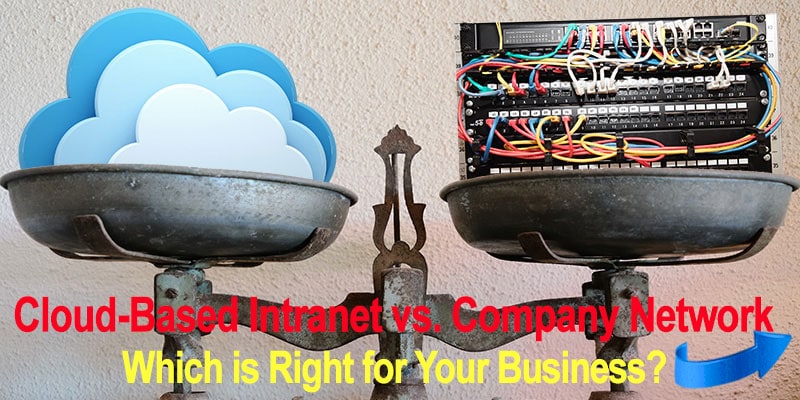Selecting which intranet platform to go for is a big decision and you’ll want to get it right first time. However, with lots of choices and options to choose from, it can be a confusing process. In this article, we make it easier by looking in detail at what’s involved and the choices that are available. As a result, you’ll be much better informed and can make a selection that works best for your organization.
Intranet Platform Needs Analysis
The starting point for selecting an intranet platform is to understand the organizational needs that are driving deployment. What pain points is your business facing that an intranet can help to resolve? It could be wanting to improve internal communications, easier sharing of information and data, more streamlined automated business processes or a desire for better joint working and collaboration across the business.

These are just some of the driving forces behind intranet deployment for many organizations. Your business may well have a different motivation.
Make sure that you consult with staff members and all the key stakeholders when undertaking your needs analysis. And while you’re at it, when conducting your research have an eye on potential content for the intranet. What sort of information and what kinds of processes do employees need to have on the intranet to get the job done more efficiently?
It’s important to have a handle on the specific needs you are seeking to address so that you select an intranet platform that meets those needs.
On-Premise Intranets
When it comes to deploying your intranet platform, there are two basic choices. The first one that we’ll look at is the on-premise intranet. Now, this can take the form of a custom-built intranet or a do-it-yourself version using downloaded software such as Drupal or WordPress. In both cases, the intranet will need to be hosted by an on-premise company server.
There are some advantages to this approach. Do-it-yourself software such as WordPress is readily available and is free to download. And if you’re a larger company with a dedicated in-house IT resource, then a custom-built option may be very attractive as it means you can design an intranet that is an exact match to your requirements. And if you already have a company server, then hosting an intranet is no big deal.
Before you rush into downloading any software, it’s important to recognize the disadvantages associated with on-premise intranets. For a start, a custom-built option is not for the faint-hearted. It can be a highly technical and involved process that requires a considerable investment of time and resources.
In addition, hosting an intranet on the company server may be convenient, but it also has its issues. For a start, there’s the sheer amount of valuable office space involved as well as the ongoing costs in terms of maintenance and upgrades.
Cloud Intranets
The second basic choice of intranet platform is the cloud-hosted option. Most cloud intranets are available in a super easy to set up format, utilizing pre-built templates. All you need to do is log on, customize the template with your own content, branding and company colors and hey presto, in a matter of hours and without any great technical knowledge, you can have a professional looking and fully functioning intranet. It really is that straightforward. What’s more, the same intuitive tools make the ongoing management of the intranet super easy too. Create and edit content, add and manage single or multiple users and restrict access to sensitive or confidential information, all in just a matter of moments and with a few clicks of the mouse. And there’s plenty of help and support available from the cloud intranet provider, including a full design service should you need it or pressure of time dictates it.
The great advantage of the cloud option is that there’s no software to download or server to maintain. And the cloud nature of the intranet provides businesses with greater flexibility as all the tools and information are accessible 24/7 via a smartphone or tablet. In companies operating in multiple time zones with large numbers of remote or peripatetic workers, the efficiencies on offer are obvious.
There are some disadvantages, however, and the main one is that this intranet platform may not be an exact match to your organizational needs in the way that an entirely bespoke option would be. In addition, businesses are not in direct control of the software itself. Having said that, for many businesses, the fact that cloud intranets are so quick and easy to set up far outweighs any disadvantages. What’s more, with the cloud option the need for piloting is eliminated as the provider has already extensively tested the software and functionality beforehand.
Security
This aspect of an intranet platform is so important that we’ve given it a separate heading. Internal and external security threats are constantly changing and are so complex that you almost need a PhD to keep on top of them. Not so if you opt for the cloud solution. You see, unlike the on-premise intranet platforms where you retain sole responsibility for intranet security as well as updates and backups, with a cloud solution, it’s the provider who has to manage that particular headache. Yes, the cloud provider retains responsibility for all the intranet platform’s security aspects including SSL encryption and firewalls. And those of you that have had experience of grappling with online security issues will be able to attest that this is an important advantage.
Intranet Costs

Intranet Platform Decision
The right choice of intranet platform for your organization will depend on a number of factors including your needs, budget and the time and resources you’re willing to invest. But for a simple to set up and manage, cost-effective and flexible choice that’s capable of growing alongside your business, a cloud intranet is hard to beat. Find out for yourself with MyHub’s free online intranet demonstration session or 14-day trial . Make the right choice today.








0 Comments